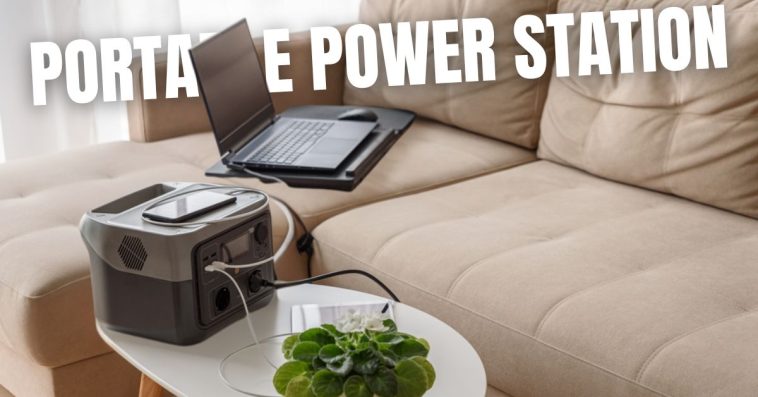Imagine working on an important project at home when the power suddenly cuts out — your laptop dies, Wi-Fi goes down, and the lights go dark. Or picture yourself camping far from the nearest outlet, yet still able to brew coffee, run your speaker, and charge your phone under a starry sky.
Welcome to the age of portable power stations — the 2025 answer to energy freedom. Compact, quiet, and powerful, these devices let you generate, store, and use energy wherever you are — no fumes, no fuel, no stress.
Let’s plug into the future of power — one that fits in your backpack, your car trunk, or even your living room.
1. What Is a Portable Power Station?
A portable power station is essentially a large, rechargeable battery system that converts stored energy into usable power for your devices and appliances. Unlike noisy gas generators, these are silent, clean, and eco-friendly.
They come with:
-
Multiple ports: AC outlets, DC car ports, USB-A, and USB-C PD.
-
Recharge options: Wall (AC), car, or solar panel.
-
Inverters: To convert DC battery power to AC household current.
-
Smart controls: LCD or app-based interfaces for monitoring usage.
Simply put — they’re your personal mini power plant, ready when the grid fails or when you’re far from civilization.
2. Why Owning a Power Station Is Essential Today?
As climate events, digital lifestyles, and remote work continue to shape modern life, the benefits of having a portable power source have expanded dramatically.
1. Uninterrupted Power — Anywhere
From New York to Nairobi, blackouts can strike unexpectedly. With a power station, you can keep essential devices running: laptops, routers, medical devices, or even small fridges.
2. Clean, Quiet, and Sustainable Energy
No fuel smell. No engine noise. No pollution. These stations use lithium or sodium-based batteries — recharged from the grid, a car, or better yet, solar panels.
3. Off-Grid Freedom
Perfect for camping, overlanding, or van life — you can work, cook, and stay connected in the most remote places. Pair with solar panels for a truly off-grid setup.
4. Remote Work and Digital Nomad Independence
In 2025, more professionals work from cabins, coasts, or converted vans. A 500–1000 Wh station easily powers laptops, Wi-Fi, and lights for an entire workday — anywhere.
5. Emergency Preparedness
Wildfires, floods, and storms are growing more frequent. Power stations ensure your lights, communication devices, and essentials stay on — even when the grid doesn’t.
6. Long-Term Cost Efficiency
While the upfront cost can be high, there are no recurring fuel costs. Combined with solar charging, they can reduce your electric bills and pay off over time.
7. New Battery Technology
2025 is witnessing rapid innovation:
-
LiFePO₄ (Lithium Iron Phosphate) batteries dominate for safety and 3,000+ charge cycles.
-
Sodium-ion batteries (like Bluetti’s Pioneer Na) are emerging — performing better in cold climates and reducing rare-metal reliance.
3. Understanding the Key Features
Here’s what to focus on before buying:
| Feature | What It Means | Why It Matters |
|---|---|---|
| Capacity (Wh) | How much energy it stores | Higher Wh = longer runtime. 500 Wh can power small devices; 2,000 Wh+ for heavy loads. |
| Continuous / Peak Power (W) | Continuous = sustained power; Peak = surge handling | Important for appliances like fridges or drills. |
| Battery Chemistry | LiFePO₄, NCM, or sodium-ion | LiFePO₄ = longer life; sodium-ion = better cold performance. |
| Recharge Speed | How quickly it fills up | Many 2025 models recharge from 0–80% in under an hour. |
| Solar Input | Max wattage it accepts from panels | The higher the solar input, the faster you can recharge off-grid. |
| Output Ports | AC, USB-C PD, DC, car | Ensures compatibility with multiple devices. |
| Weight & Portability | Size and mobility | Compact models suit travel; larger ones serve as home backup. |
| Safety / Warranty | BMS protection & coverage | Good systems protect against overcharge, short circuit, or overheating. |
4. Top Portable Power Stations to Watch
Below is the most current, research-backed lineup of the best portable power stations of 2025, representing every budget and use case.
1. EcoFlow DELTA 3 Plus
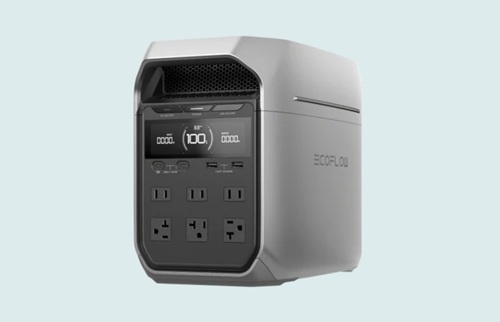
Best Overall for Home Backup & Professionals
-
Capacity: ~2,000 Wh | Output: 2,400 W (Surge 5,000 W)
-
Battery Type: LiFePO₄
-
Recharge Time: 0–80% in ~50 min via AC
-
Solar Input: Up to 1,200 W
-
Why it shines: Ultra-fast charging, smart app control, UPS mode, expandable storage.
-
Best for: Home offices, small businesses, or emergency backup power.
2. EcoFlow RIVER 3 / RIVER 3 Max
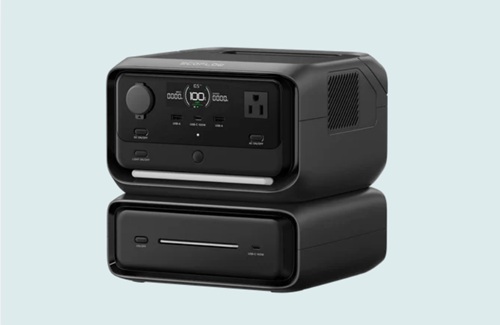
Best Compact & Travel-Friendly Option
-
Capacity: 512 Wh | Output: 500 W (Surge 1,000 W)
-
Recharge Time: ~60 min to 80%
-
Weight: ~7 kg
-
Why it shines: Lightweight, budget-friendly, and perfect for camping or remote work trips.
-
Best for: Travelers, freelancers, photographers, and weekend campers.
3. Anker SOLIX F3800 / F3800 Plus
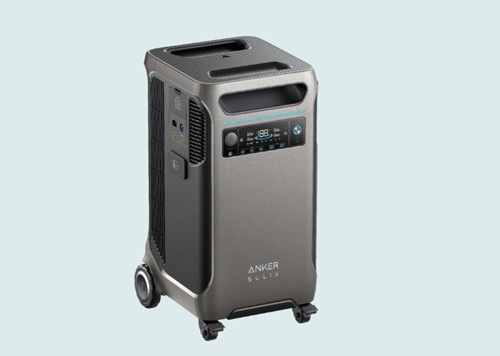
Best for Heavy-Duty & Home Power Backup
-
Capacity: 3,840 Wh (expandable to >26 kWh)
-
Output: 6,000 W dual-voltage
-
Recharge Options: Solar, AC, EV, and grid
-
Why it shines: Can power entire households and charge EVs. Modular design allows stacking battery packs.
-
Best for: Homeowners, RV owners, emergency prepper setups.
4. Jackery Explorer 2000 Plus / 1000 v2
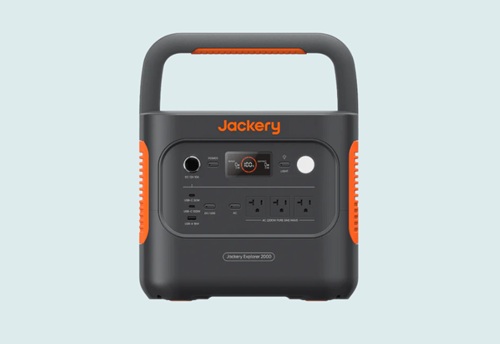
Best User-Friendly & Globally Available Ecosystem
-
Capacity: 2,000 Wh (expandable to 12 kWh)
-
Battery Type: LiFePO₄
-
Recharge: 100% in 2 hrs (AC or solar)
-
Why it shines: Reliable global brand, easy setup, great for outdoor pros and families.
-
Best for: Reliable mid-size backup for travel or home essentials.
5. Bluetti AC500 + B300K Modular System
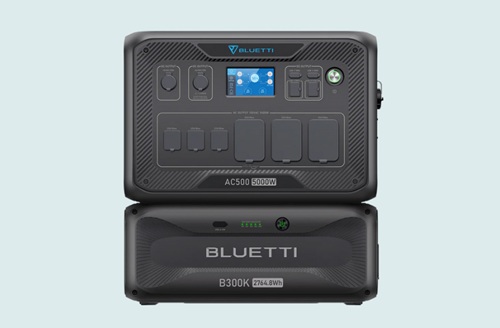
Best Modular Power System for Whole-Home Energy
-
Capacity: 3,072 Wh base (expandable to 18,000 Wh+)
-
Output: 5,000 W continuous, 10,000 W surge
-
Battery Type: LiFePO₄
-
Why it shines: Fully modular — stack battery packs as needed. Excellent for solar integration and long-term reliability.
-
Best for: Off-grid homes, small offices, or serious preppers.
6. Goal Zero Yeti 1500X
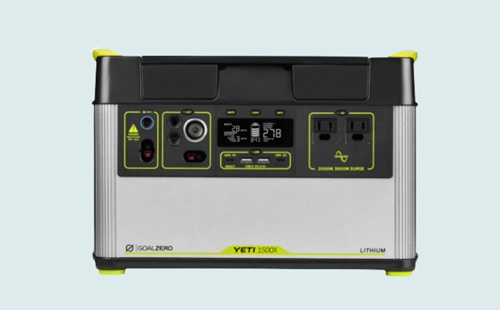
Most Reliable Classic Brand for Global Users
-
Capacity: 1,516 Wh | Output: 2,000 W
-
Recharge: ~90 min to 80%
-
Why it shines: Rugged, time-tested design, easy app monitoring, and a strong service network worldwide.
-
Best for: Travelers and professionals who value dependability over trendiness.
7. Fanttik EVO 300
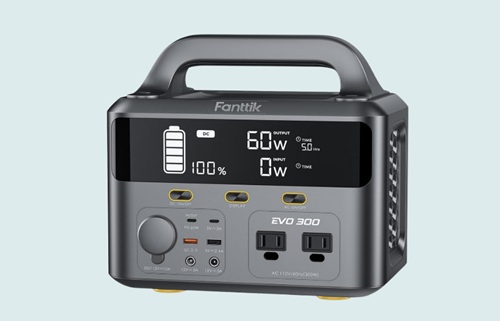
Best Ultra-Portable Budget Options
-
Capacity: 268–300 Wh | Weight: ~4 kg
-
Recharge: ~40–60 min to 80%
-
Why it shines: Compact, affordable, and ideal for quick trips, photography, and emergencies.
-
Best for: Minimalists, hikers, solo travelers, students.
5. How to Choose the Right Power Station for You
Picking the perfect power station can feel overwhelming with so many brands and specs. But once you understand what really matters for your specific lifestyle, it becomes easy to find your match. Let’s break it down step by step.
Step 1: Identify Your Core Purpose
Ask yourself what you need the power station for.
Different goals = different priorities:
-
Camping & weekend travel: Focus on portability and quick charging (500–700 Wh).
-
Remote work / digital nomad life: Balance between weight and runtime (1,000–1,500 Wh).
-
Home backup: Prioritize large capacity and high watt output (2,000 Wh+).
-
Van life / RVs: Modular, solar-friendly setups with expandable batteries.
-
Emergency preparedness: Reliability, UPS mode, and longevity matter most.
Pro Tip: If you’re unsure, start with a 1,000 Wh model — versatile enough for travel, work, and short-term backup.
Step 2: Calculate Your Power Requirements
This step helps you size your power station correctly.
Use this formula:
Total Watt-hours (Wh) = Device Wattage × Hours of Use × Number of Devices
Example (remote work setup):
| Device | Power (W) | Hours | Total Wh |
|---|---|---|---|
| Laptop | 60 | 5 | 300 |
| Wi-Fi router | 15 | 8 | 120 |
| LED lights | 20 | 6 | 120 |
| Smartphone | 10 | 3 | 30 |
| Camera battery | 15 | 2 | 30 |
| Total | 600 Wh |
➡️ Choose at least a 1,000 Wh power station for flexibility and efficiency loss (about 10–15% is lost during conversion).
Step 3: Know Your Battery Types
Battery chemistry determines safety, performance, and lifespan:
| Type | Lifespan | Safety | Weight | Notes |
|---|---|---|---|---|
| LiFePO₄ (Lithium Iron Phosphate) | 3,000–5,000 cycles | Very high | Heavier | Best overall for long-term users |
| NCM/NCA (Lithium Nickel) | 800–1,500 cycles | Moderate | Lighter | Common in smaller or budget models |
| Sodium-ion (New in 2025) | 2,000+ cycles | Very high | Moderate | Performs well in cold; eco-friendly |
For 2025 and beyond, LiFePO₄ is the clear winner for safety and longevity — now standard in most top-tier models like Bluetti, Jackery, and EcoFlow.
Step 4: Balance Portability and Power
Here’s a quick guide to help you match your power size with your lifestyle:
| Capacity (Wh) | Ideal For | Typical Weight | Example Models |
|---|---|---|---|
| 200–500 Wh | Hiking, photography, short camping trips | 4–7 kg | Fanttik EVO 300, Bluetti EB3A |
| 600–1,000 Wh | Digital nomads, small devices, car camping | 8–12 kg | EcoFlow RIVER 3 Max, Jackery 1000 v2 |
| 1,500–3,000 Wh | RV, home office backup, off-grid cabins | 13–25 kg | EcoFlow DELTA 3 Plus, Jackery 2000 Plus |
| 3,000+ Wh | Whole-home or RV power systems | 30+ kg | Bluetti AC500 + B300K, Anker F3800 |
Step 5: Recharge Flexibility
In 2025, you don’t want a power station that takes forever to recharge. The best ones offer multi-mode charging:
-
AC wall: Fastest method — some recharge 0–80% in under 1 hour.
-
Solar panels: Free, sustainable — look for 400–1,200 W solar input compatibility.
-
Car charging: Handy for long drives (though slower).
-
Dual charging: Combine solar + AC for super-fast top-ups.
Step 6: Brand Support and Warranty
Stick to trusted brands with proven after-sales support:
-
EcoFlow and Jackery → Global service and 2–5-year warranties.
-
Bluetti → Modular upgrades, 5-year LiFePO₄ warranty.
-
Anker SOLIX → Expanding worldwide, strong app integration.
-
Goal Zero → Best for international reliability.
6. Tips for Safe, Efficient, and Long-Term Use
Your power station is an investment — treat it like one. These best practices can easily extend its lifespan beyond 5–7 years.
Battery Health Tips
-
Avoid full discharge: Try not to drain below 10–20% unless necessary.
-
Keep between 20–80% charge for storage.
-
Recharge every 3–6 months if unused.
-
Store in a cool, dry place (15–25°C) to prevent heat degradation.
-
Avoid extreme cold: If unavoidable, pre-warm the battery before charging.
Usage Best Practices
-
Don’t overload ports: Check the total watt draw before connecting devices.
-
Use quality cables: Cheap cords can reduce charging efficiency.
-
Ventilate during heavy use: Prevents overheating under continuous load.
-
Enable ECO or UPS mode if your model supports it — this optimizes energy use.
-
Keep firmware updated: Modern power stations (EcoFlow, Anker, Bluetti) receive OTA updates that improve charging profiles and battery protection.
Solar Optimization Tips
If you plan to pair your unit with solar panels:
-
Choose monocrystalline panels (highest efficiency).
-
Match panel voltage and connector type (XT60, MC4, DC7909, etc.) to your power station.
-
Use tilt stands to maximize sunlight exposure.
-
Clean your panels regularly for 10–15% better efficiency.
Example: The EcoFlow DELTA 3 Plus can reach full charge in about 2 hours using dual 400 W panels under good sunlight conditions.
Safety Essentials
Even though these are safer than fuel generators:
-
Never cover vents or fans.
-
Avoid wet conditions unless IP-rated for water resistance.
-
Keep out of reach of children or pets.
-
Always unplug when not in use to prevent phantom draw.
7. Real-World Scenarios & Recommendations
| Scenario | Recommended Model | Why |
|---|---|---|
| Weekend camping or photography | EcoFlow RIVER 3 / Fanttik EVO 300 | Lightweight, quick charge, solar-ready |
| Remote work on the go | Jackery 1000 v2 or EcoFlow RIVER 3 Max | Enough juice for laptops, Wi-Fi, lights |
| Home office or small appliances backup | EcoFlow DELTA 3 Plus / Bluetti AC500 | UPS-ready, strong output |
| Whole-home backup or RV life | Anker SOLIX F3800 / Bluetti AC500 system | Modular expansion, multi-kWh storage |
| Emergency preparedness | Goal Zero Yeti 1500X | Trusted reliability, global availability |
8. The Future of Portable Power (2025 and Beyond)
Portable power stations are evolving far beyond just “battery boxes.” They’re becoming the heart of modern energy ecosystems — smarter, cleaner, and more integrated than ever.
Trend 1: AI-Powered Smart Management
Upcoming models use AI-based load management to predict your energy needs and automatically optimize which ports or devices draw power.
Think of it like a digital assistant for your electricity.
Trend 2: Solar + Home Integration
Brands like EcoFlow and Bluetti are now offering home power kits that integrate solar panels, smart distribution panels, and battery systems.
Soon, you’ll be able to switch seamlessly between solar, grid, and battery power — reducing dependence on centralized utilities.
Trend 3: Modular and Swappable Batteries
Future-ready systems like Anker SOLIX and Bluetti AC500 use hot-swappable batteries. Need more juice? Just slide in another pack without powering down.
This makes them scalable — from daily use to full-home backup.
Trend 4: Cold-Weather-Ready Chemistry
Sodium-ion batteries, debuting in products like Bluetti’s “Pioneer Na,” are proving more efficient in extreme cold — a game-changer for users in Canada, Scandinavia, or high-altitude areas.
Trend 5: App Ecosystems and Connectivity
Power stations now pair with smart apps that show real-time usage, charging curves, and even remote control functions.
For instance, Anker’s SOLIX app can trigger smart charging windows to take advantage of cheaper nighttime electricity rates — helping users save money while staying sustainable.
Trend 6: Toward Carbon-Neutral Living
Portable power stations are becoming part of a bigger environmental shift — enabling people to generate and store renewable power on their own terms.
As solar adoption grows and battery recycling improves, these devices could redefine what “personal energy independence” means in the next decade.
Conclusion
Owning a portable power station in 2025 isn’t just about convenience — it’s about freedom, sustainability, and preparedness.
Whether you’re powering your next great adventure, protecting your home during an outage, or reducing your reliance on the grid, portable power stations are one of the smartest investments you can make this year.
As technology advances, they’re becoming:
-
More efficient
-
Faster to recharge
-
Safer and longer-lasting
-
Better integrated with solar and smart home systems
So, if you haven’t joined the portable power revolution yet, 2025 is your moment. Find a station that fits your lifestyle, pair it with renewable energy, and experience what it means to live truly unplugged yet always powered.


